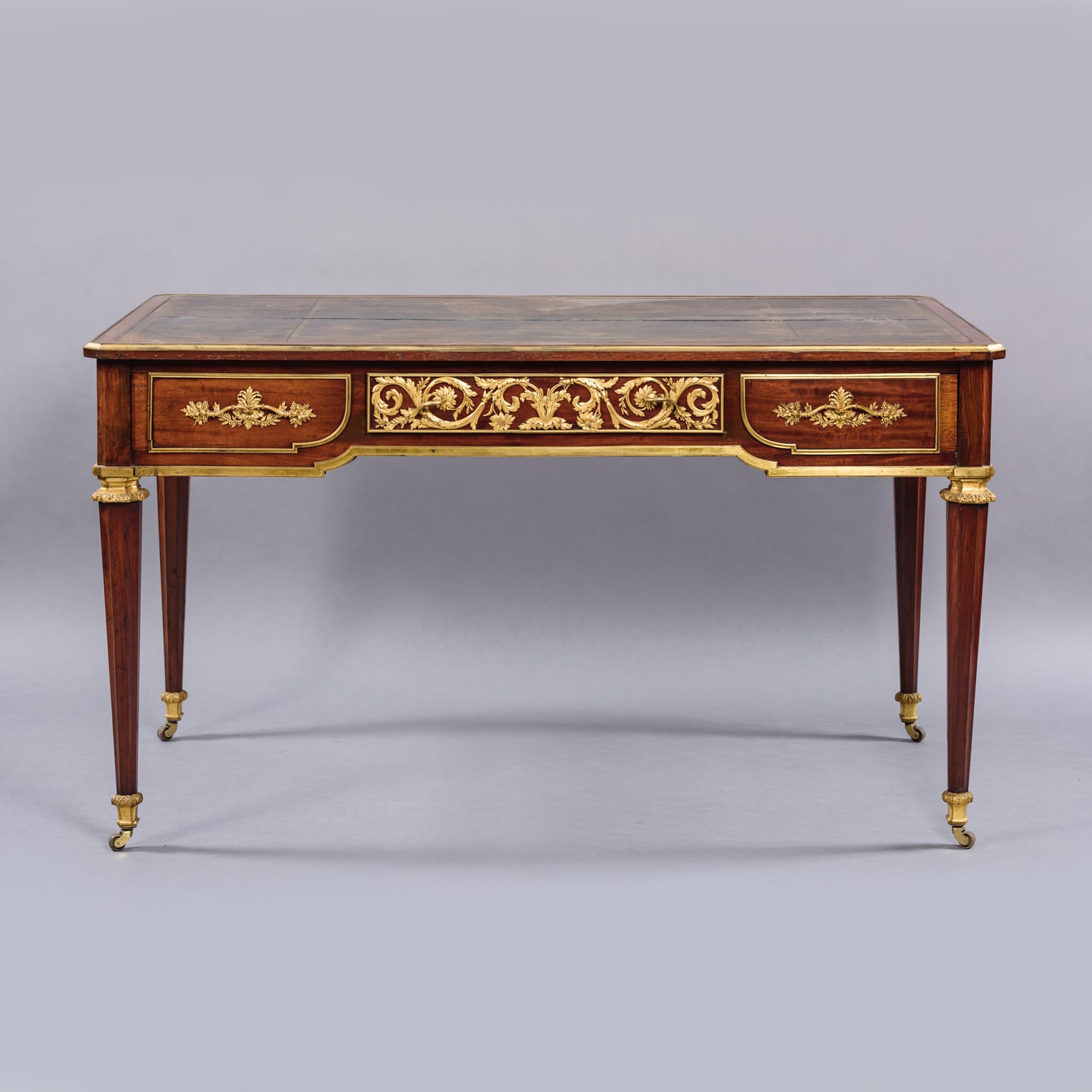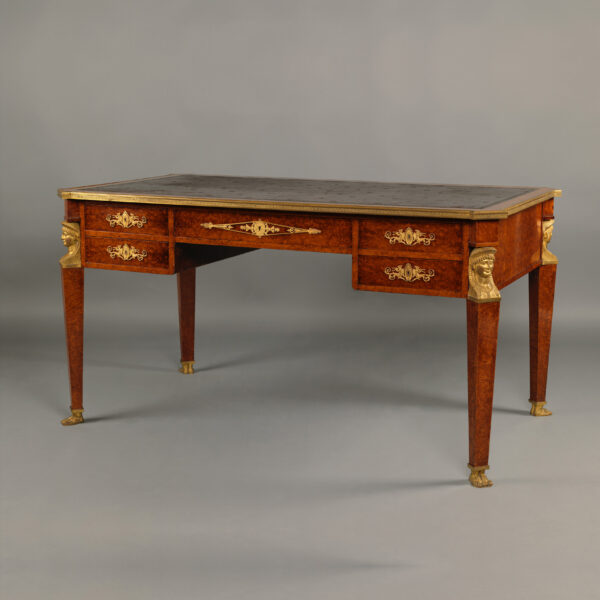After Jean-Henri Riesener
A Fine Louis XVI Style Gilt-Bronze Mounted Mahogany Bureau Plat in the Manner of Riesener
£28,000
A Very Fine Louis XVI Style Gilt-Bronze Mounted Mahogany Bureau Plat in the Manner of Riesener. This elegant mahogany bureau plat has a leather top...
Dimensions
Height: 77 cm (31 in)Width: 136 cm (54 in)
Depth: 76 cm (30 in)
Description
A Very Fine Louis XVI Style Gilt-Bronze Mounted Mahogany Bureau Plat in the Manner of Riesener.
This elegant mahogany bureau plat has a leather top with a gilt-tooled palmette border above a pair of matching leather-lined slides. The frieze contains two short drawers and a long central drawer with fine gilt-bronze mounts to one side and conforming dummy drawers to the reverse.
The desk is mounted with exceptionally fine mercury-gilded mounts cast with scrolling acanthus, floral baskets and ribbon tied bands.
The bureau plat is inspired from the work of the French ébéniste Jean-Henri Riesener. The structure of the bureau is related to a bureau plat stamped by Riesener that is in the collections of the Château de Versailles (inv. no. OA6085). The model for the extremely fine handle mounts are found on a bureau à cylindre stamped by Riesener sold at Christie’s New York, 22 November 2020, lot 231. The central mount, featuring stylised foliage, on each side of the present bureau is found again on a bureau plat stamped Riesener in the collections of the J. Paul Getty Museum (inv. no. 71.DA.102).
French, Circa 1880.
The bureau is in goood original unrestored condition. It would benefit from the leather top being replaced, which can be arranged if required.
Date
Circa 1880
Origin
France
Medium
Gilt-Bronze and Mahogany
Jean-Henri Riesener (1735-1806) lived in Paris and was the foremost cabinet-maker of his generation and the successor to the court patronage of Jean-Francois Œben, whose widow he married in 1767.
From 1774 to 1784, Riesener supplied more than 938,000 livres worth of furniture to the Garde-Meuble Royal. He was responsible for many important contributions to the formation of the Louis XVI style in France, of which he was undoubtedly the master.
Riesener began his career for the monarchy with the roll-top desk for Louis XV placed in his inner study. Commissioned in 1760 from his father-in-law and master Œben, it is a piece of furniture exceptional for its novelty, the refinement of its marquetry, the quality of its bronze details and above all the ingeniousness of its mechanism: all the desk closes with a single turn of the key and opens just by pressing a button. Completed in 1769, it was modified by him during the Revolution when he had to remove the royal symbols. The prestige of this piece of furniture was immense and definitively established the reputation of Riesener.
From this time on, there was no shortage of commissions from the court and for ten years he was the principal supplier to the royal residences. But his outrageous prices lost him a part of his clientele which turned to his rival Benneman. Marie-Antoinette, however, remained faithful to him. Riesener produced his most graceful and innovative pieces of furniture for Marie-Antoinette: In particular for her boudoir at Fontainebleau, he produced fragile furniture decorated with mother-of-pearl that was unique in its genre. Pearl was a particularly exotic material at that time and using it to cover the entire surface of an object was the height of luxury.
His furniture was much copied during the nineteenth century, in particular the ‘Bureau du Roi’ at Versailles, of which a superb version was made for the 4th Marquess of Hertford and is now in the Wallace Collection.
Bibliography:
Ledoux-Lebard, Denise. Les Ebénistes du XIXe siècle, Les Editions de l’Amateur, (Paris), 1984; p.555.
Kopf, Silas. A Marquetry Odyssey: Historical Objects and Personal Work, First edition, 2008; p.109.













 Print
Print


